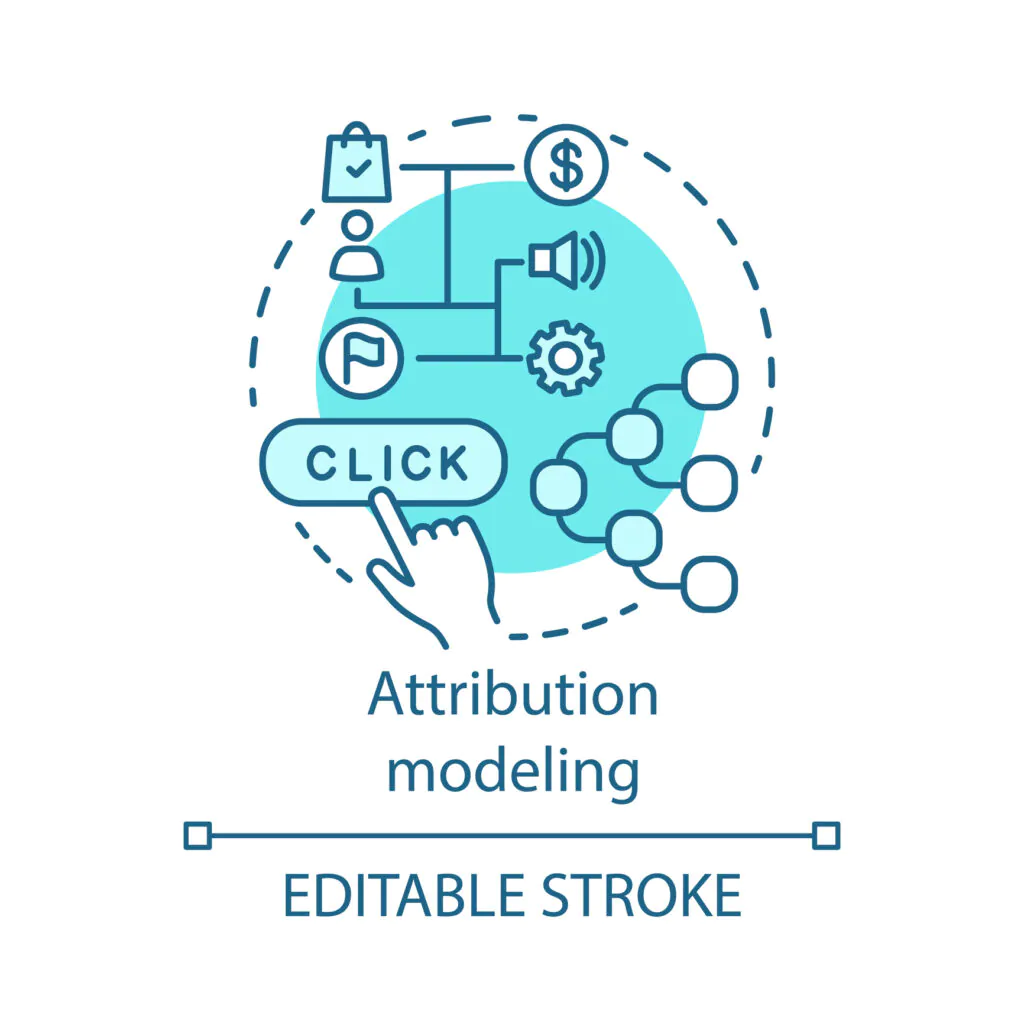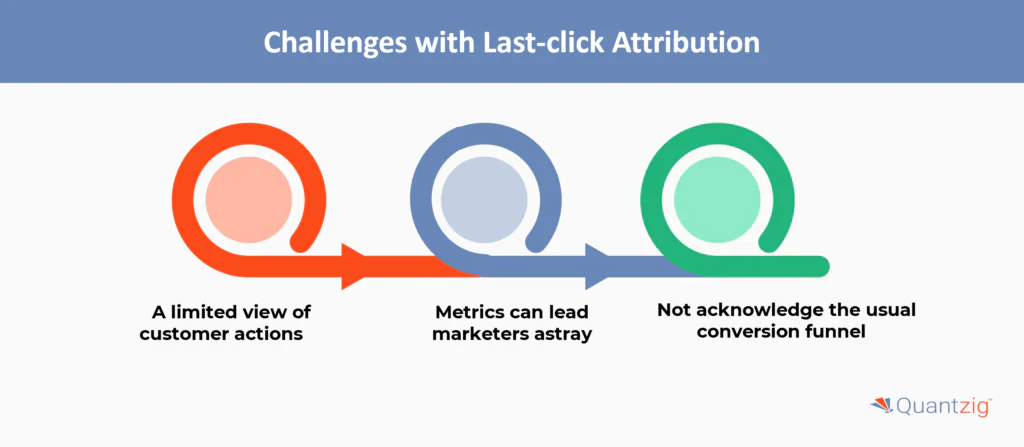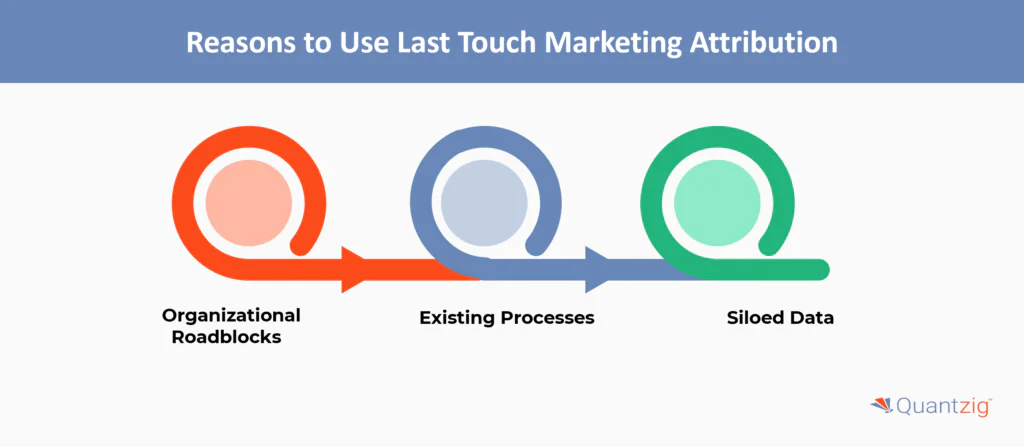Table of Contents
Table of Contents
- Introduction
- Quantzig’s Expertise in Last-Click Attribution
- Overview of an attribution model
- What is last-click attribution?
- Last-click vs first-click attribution
- Why do marketers use last-click attribution?
- What’s the problem with last-click attribution?
- How marketers can go beyond last-click attribution
- The Challenges of Last Click Attribution
- Why Do Marketers Use Last Touch Marketing Attribution?
- Quantzig Solutions portfolio
- Conclusion
Author: Associate Vice President, Analytics and Data Strategy, Quantzig.
Key Takeaways for Last-Click Attribution
- Importance of Evolving Attribution Models: Last-click attribution, while once valuable, now presents significant limitations in understanding customer behavior and optimizing omnichannel marketing efforts. Marketers must recognize the importance of evolving beyond last-click attribution to more sophisticated models that provide a comprehensive view of the customer journey.
- Challenges with Last-Click Attribution: Last-click attribution offers a limited perspective on customer actions, potentially leading to misguided resource allocation decisions. Marketers may overlook the significance of top-funnel efforts and fail to understand the entire conversion funnel, resulting in missed opportunities for optimization and revenue growth.
- Significance of Unified Marketing Measurement (UMM): Transitioning to UMM enables marketers to overcome the shortcomings of last-click attribution by aggregating data across multiple touchpoints and attribution models. With a holistic view of each campaign’s success, teams can make more informed decisions and optimize strategies for greater effectiveness and ROI.
- Necessity of Updating Attribution Strategies: While organizational roadblocks, existing processes, and siloed data may hinder the transition away from last-click attribution, companies must update their attribution strategies. By embracing more advanced methodologies like UMM, organizations can unlock deeper insights into customer behavior and optimize marketing efforts for improved performance and success.
Introduction
Marketing attribution is becoming a more widely utilized method for marketers to gain insight into how their efforts affect revenue and profits. The last-click attribution model is one such attribution approach you could implement. However, you may be wondering if this is truly the optimal model for your organization.
In this article, you will discover:
- An explanation of last-click attribution and how to apply it
- Potential issues you may encounter with last-click attribution
- How implementing attribution can provide you with more insightful data
Book a demo to experience the meaningful insights we derive from data through our analytical tools and platform capabilities. Schedule a demo today!
Request a Free DemoQuantzig’s Expertise in Last-Click Attribution for a US-based Retail Multinational Brand
| Category | Details |
|---|---|
| Client Details | A leading gift items, greeting cards and keep sakes seller (Online / offline) in the world. |
| Challenges Faced by The Client | The client was looking for different ways of attributions for their digital channels. |
| Solutions Offered by Quantzig | Quantzig optimized conversion-driven spending by processing real-time data from digital sources, streamlining attributions with a last-click model, and implementing MMM + MTA models for customer-level, quick decisions and performance reporting, including A/B testing, keyword optimization, SEO, and SEM. |
| Impact Delivered | We helped the client by enabling a digital performance control tower to monitor channel performances and conversions, streamlining analytics use cases such as campaign planning, A/B testing, and budget allocations, resulting in a 15% improvement in conversion rates for H3 2023. |
Client Details
Client is a leading gift items, greeting cards and keep sakes seller (Online / offline) in the world.
Challenges Faced by the Client
The client was searching for different attribution methods of crediting their digital channels.
Solutions Offered by Quantzig
Quantzig concentrated much more on conversion-driven spend optimizations while assisting the client in streamlining attributions using the last-click model. The last click model was immediately used, capturing data from original digital sources at the right moment and processing it in real time. We also implemented the MMM + MTA Models for fast decisions at the individual customer/journey level as well as the performance reporting dashboards (Keyword optimization, A/B testing, SEO, and SEM optimizations).
Impact Delivered
We provided the client with a digital performance control tower so they could track conversions and channel performances. This helped to streamline use cases related to analytics, including budget planning, A/B testing, campaign planning, and allocations. Through campaign optimization for H3 2023, we were able to increase their customer conversion rates by 15%.
What is an Attribution Model?

An attribution model comprises a set of guidelines that specify how an analytics platform assigns credit for clicks, form fills, and conversions. Without an attribution model, measuring the success of marketing efforts would be extremely difficult. Attribution enables calculating the return on investment of marketing channels so that the budget can be directed toward activities with the potential to increase revenue.
What is Last-click Attribution?
Last-click attribution is a method that tracks the final touchpoint, such as an advertisement or link, that a customer interacts with before completing a purchase. It assigns full credit for driving the sale to that last click or engagement.
This form of attribution was very useful for marketers in the past. For example, if a customer buys a pair of shoes online, data would show the last ad or page they clicked before checking out. This helped marketers determine which ads or products were most effective at leading to sales. By seeing what a customer clicked on right before purchasing, marketers could gain insight into what content and campaigns were successful in converting customers.
First-click vs Last-click Attribution
| Aspect | First-click Attribution | Last-click Attribution |
|---|---|---|
| Definition | Attributes the conversion to the first interaction with the customer. | Attributes the conversion to the last interaction with the customer. |
| Focus | Emphasizes the initial point of contact that introduced the customer to the brand. | Emphasizes the final interaction that directly led to the conversion. |
| Pros | Highlights the importance of brand awareness and early-stage marketing efforts. | Recognizes the impact of closing strategies and the effectiveness of final touchpoints. |
| Cons | May undervalue mid and late-stage interactions that contributed to the conversion. | May overlook the significance of initial touchpoints and nurturing efforts. |
| Ideal For | Businesses aiming to understand which channels are best at attracting initial interest. | Businesses looking to identify the most effective channels for closing sales. |
| Common Use Cases | Content marketing, SEO, social media campaigns focused on awareness. | Retargeting campaigns, email marketing, and direct response advertising. |
| Impact on Strategy | Encourages investment in top-of-the-funnel marketing activities. | Promotes focus on bottom-of-the-funnel marketing activities and conversion optimization. |
| Example | If a customer first clicks on a Google ad and later converts through an email link, the Google ad gets the credit. | If a customer first clicks on a Google ad and later converts through an email link, the email link gets the credit. |
Also Read: Maximizing Marketing Budgets with Campaign ROI Analysis
Get started with your complimentary trial today and delve into our platform without any obligations. Explore our wide range of customized, consumption driven analytical solutions services built across the analytical maturity levels.
Start your Free Trial TodayWhy do Marketers Use Last-click Attribution?
There are three main reasons why marketers utilize last-click attribution:
- It is simple to implement and utilize
- It provides important insight into a crucial stage of the customer’s journey
- Transitioning away from last-click attribution is challenging
Last-click attribution is easy to set up because of tools like Google Analytics. By default, Google’s attribution method defaults to last-click attribution.
And for many marketers, this makes sense. You want to know what is transforming your leads and prospects into customers. Especially if you work in paid advertising.
Given that last-click attribution is so ingrained with Google Analytics, it can be difficult to move away from this model type. In most cases, you would need to invest in a separate attribution tool to better comprehend how your marketing is functioning through every touchpoint.
What’s the Problem with Last-click Attribution?

Marketing strategies that rely on last-click attribution are flawed in today’s digital marketing environment. Making resource allocation decisions based on last-click attribution can severely hurt revenue growth.
The reason is as follows.
1. A limited view of customer actions
Last-click attribution provides a narrow perspective on customer behavior. While it is superior to having no attribution model, it only captures a limited snapshot of how a customer interacts with a business.
2. Metrics can lead marketers astray
- Marketing metrics can misguide marketers if they solely rely on last-click attribution. This method only shows how different marketing channels directly convert leads. It doesn’t demonstrate how marketing impacts other touchpoints in the customer journey. However, over-relying on conversion metrics causes marketers to neglect the right metrics. Once marketers identify the tactics that close leads, they stop examining metrics that reveal how leads initially find their business.
- For example, a company might create high-quality content that attracts significant organic website traffic. But with last-click attribution, marketers instead prioritize PPC ads driving bottom-funnel conversions. This could lead them to overlook their blog content. As they neglect top-funnel efforts, fewer leads enter the funnel, reducing close rates. Maintaining a complete view of lead journeys will help marketers set the right priorities.
3. Last-click doesn’t acknowledge the usual conversion funnel
When marketers exclusively use last-click attribution, they place too much weight on marketing channels that solely generate conversions. Customer journeys consist of three unique phases. Grasping each phase and how various channels fit into these functions is extremely important. Certain channels will be more effective at initiating new customer journeys, while others are better at concluding them. Comprehending the roles your channels fulfill enables you to precisely enhance your strategy. With last-click attribution, you may end up pursuing metrics that are ultimately insignificant.
How marketers can go beyond last-click attribution
With just last-click attribution, there are so many obstacles that it’s puzzling why marketers rely on it at all. However, businesses often struggle to move past the last click due to data being siloed.
To put it another way, to fully understand the customer journey, you need to connect your lead and website data to your CRM. But you also have to connect all of that to platforms like Google Analytics, Facebook, Google Ads, etc. Doing this is no simple task. While you can easily track lead volume, tracking where that lead originated and continuing to monitor their engagement with your site and content is more difficult.
What are the Challenges of Last Click Attribution?
While marketers have started shifting from last-click attribution to more precise multi-touch attribution models, many companies are still reluctant to make the switch. Sticking with last-click attribution could be a critical error since it has major flaws when it comes to accuracy. Last Click also faces growing challenges as customer journeys become more intricate.
1. A Limited Understanding of Customers
While last-click attribution provides more insight than having no attribution model, it is a basic way to measure impact. This is mainly because conversion credit is only given to the final platform or channel the user converted from. With last-click attribution, there is a tendency to favor direct visits, which can make marketers uncertain about how their brand-building and awareness efforts influence the overall campaign.
By only looking at the last touchpoint customers interacted with, last-click attribution implies that people make purchases on impulse without prior research. But consumer behavior indicates that people rarely buy on a whim with no prep work. Instead, consumers start by identifying a problem they want to solve. After weeks of deliberation and engaging with various solutions, they eventually make an informed purchase decision.
Let’s say a webinar provided the tipping point for a customer to convert. While it’s useful to know the webinar drove the conversion, it doesn’t explain what led the prospect to register for the webinar originally. Maybe they were encouraged by your organization’s Twitter account. So touch attribution could provide misleading insights that lead to poor optimizations. For example, reducing the social media budget and allocating more to webinars. Since a weakened social presence would dampen interest in webinars, the overall campaign would suffer.
2. Misleading Metrics Lead Marketers Astray
As mentioned previously, the last piece of content that prospects interact with before converting is not necessarily the sole reason for their conversion. However, attribution models that only credit the final touchpoint lead marketers to believe those assets are critical for driving conversions. This results in marketers underestimating the impact of their brand awareness and relationship-building efforts.
For example, imagine your company’s newly created blog increased traffic ten times in one quarter. However, your last-click attribution model shows the blog is driving zero conversions since people are purchasing directly from your website. This thinking is very flawed – the blog posts are having a significant impact by repeatedly driving traffic to your site.
Many assets that ultimately drive conversions rely initially on non-branded campaigns to attract prospects. When people look to fulfill a need, they typically search non-branded terms to find more information and resolve it. During this discovery phase, prospects aren’t ready to purchase yet. Over time, they become more certain of what they want to buy. If they engage with many of your non-branded assets, this will make them more likely to choose your product. If a company fails to invest in these non-branded assets, a competitor will likely capture their attention instead. These prospects will enter a competitor’s sales funnel rather than yours – resulting in lost leads for your organization.
3. Last Touch Marketing Attribution Ignores the Standard Conversion Funnel
Because prospective customers research from many sources before buying, turning prospects into customers involves multiple steps. When companies try to understand how leads become buyers, they often use a framework called the “conversion funnel.” The diagram above shows a typical conversion funnel. As you can see, last-click tracking only captures a small, final website interaction at the very bottom of the funnel. It doesn’t account for building awareness, interest, or desire – three essential prerequisites for getting consumers to act. To increase conversions, businesses need to consider every stage of the conversion funnel. However, last-click attribution misses the mark in this regard.
Also Read: Track Business Progress with Marketing Analytics Dashboard
Experience the advantages firsthand by testing a customized complimentary pilot designed to address your specific requirements. Pilot studies are non-committal in nature.
Request a Free PilotWhy Do Marketers Use Last Touch Marketing Attribution?

With so many flaws apparent in last-click attribution efforts, it begs the question – why is this method still utilized at all? Typically, last-click attribution is the method of choice for organizations subject to rigid organizational structures. As the last click became a more dated model, organizations are having difficulty revamping their marketing attribution efforts for three primary reasons:
1. Organizational Roadblocks
Shifting away from only evaluating marketing performance based on the last ad click before a purchase is a major change, and many companies are unsure of how to begin this transition – or even what the best approach to marketing attribution would be for their specific situation.
2. Existing Processes
Many companies have created rewards for marketing departments to generate more sales, leading to higher pay or bonuses. This seems like a good concept, but marketing teams will be reluctant to switch from the familiar last-click attribution model – unless top executives explicitly support the change.
3. Siloed Data
Marketing departments within an organization may not be readily sharing customer information. This lack of open data exchange makes it challenging to get a complete view of customer interactions across all touchpoints. For instance, the content marketing and social media teams likely have divergent objectives and see no need to collaborate by sharing insights. To address this, companies should work to establish a shared overarching goal for the entire marketing department.
While superior marketing attribution methodologies exist, it is clear why some organizations continue with the status quo. However, companies must take steps to update their attribution strategies. If not, they risk unsuccessful attempts at campaign optimization that could negatively impact overall marketing return on investment.
Quantzig Solutions portfolio
Quantzig offers advanced marketing analytics solutions that can help businesses overcome the limitations of last-click attribution and optimize their marketing strategies. By leveraging cutting-edge data analytics techniques, we can provide comprehensive insights into customer behavior across multiple touchpoints, enabling businesses to understand the entire conversion funnel and identify the true drivers of conversions. With Quantzig’s expertise in data integration and advanced attribution modeling, businesses can transition from last-click attribution to more sophisticated attribution models like multi-touch attribution or unified marketing measurement. This empowers organizations to make data-driven decisions, allocate marketing resources effectively, and maximize ROI. With our tailored analytics solutions, businesses can unlock the full potential of their marketing efforts and drive sustainable growth in today’s dynamic digital landscape.
Experience the advantages firsthand by testing a customized complimentary pilot designed to address your specific requirements. Pilot studies are non-committal in nature.
Request a Free PilotConclusion
Fortunately, last-click attribution is not the only available marketing attribution method. As mentioned, to better understand customers and more accurately reflect the sales funnel, marketing teams should transition to unified marketing measurement. UMM enables marketers to aggregate data across attribution models into one comprehensive measurement. With this holistic view of each campaign’s success, teams can use UMM to determine which digital channels and touchpoints played the biggest role in driving conversions for particular users. This allows for more precise campaign insights.
Unified marketing measurement provides a complete overview of the customer’s full journey – from initial touchpoint to final click – on a detailed level that can be focused on specific business outcomes like sales. Best of all, a powerful marketing attribution platform can deliver reliable, data-driven insights on how to optimize campaign performance moving forward, leading to greater marketing success.



